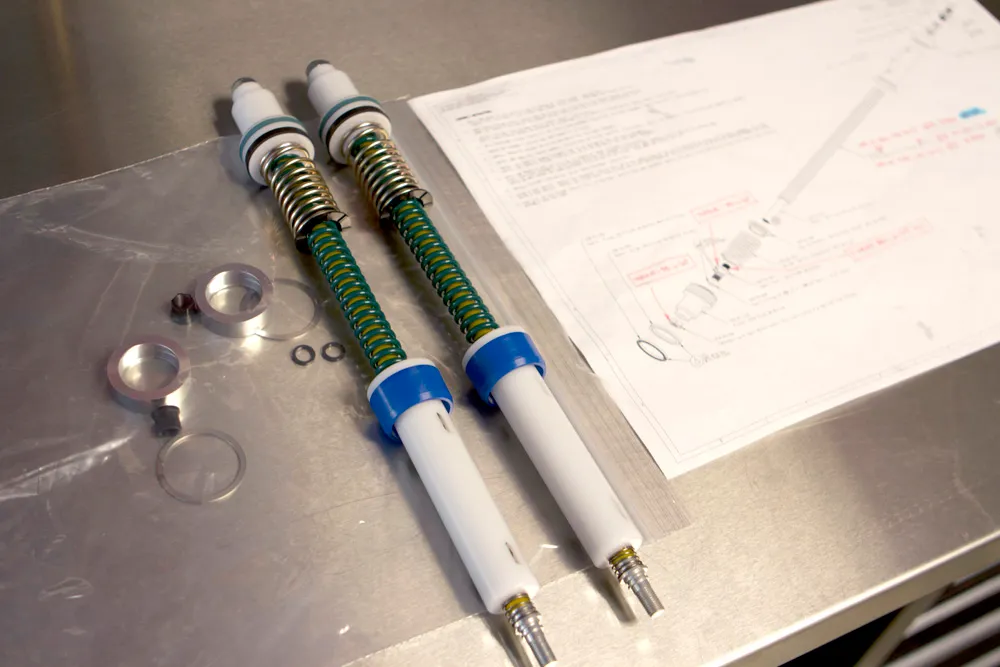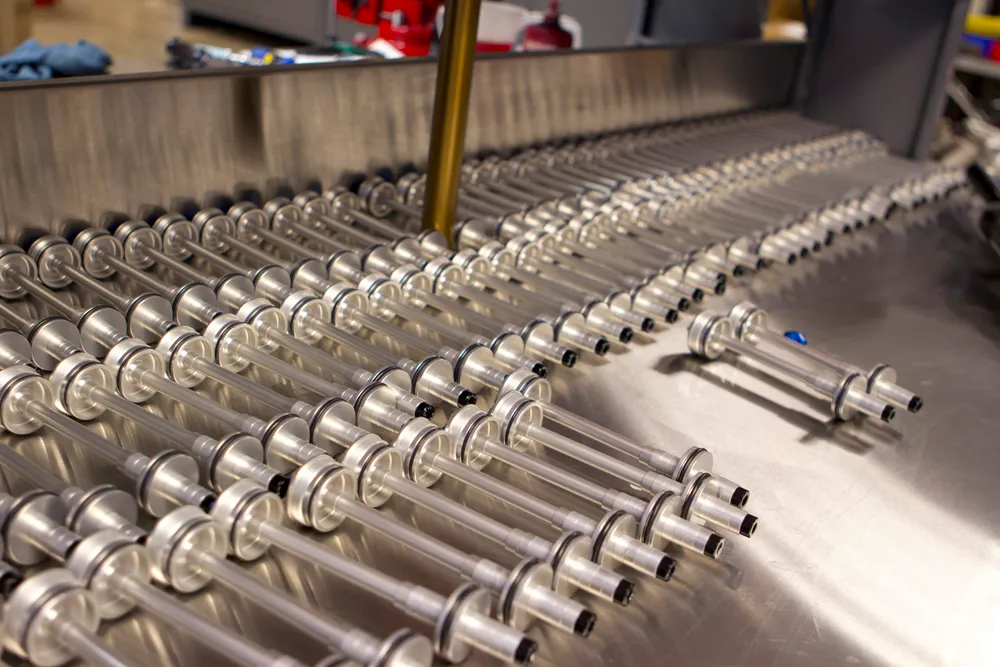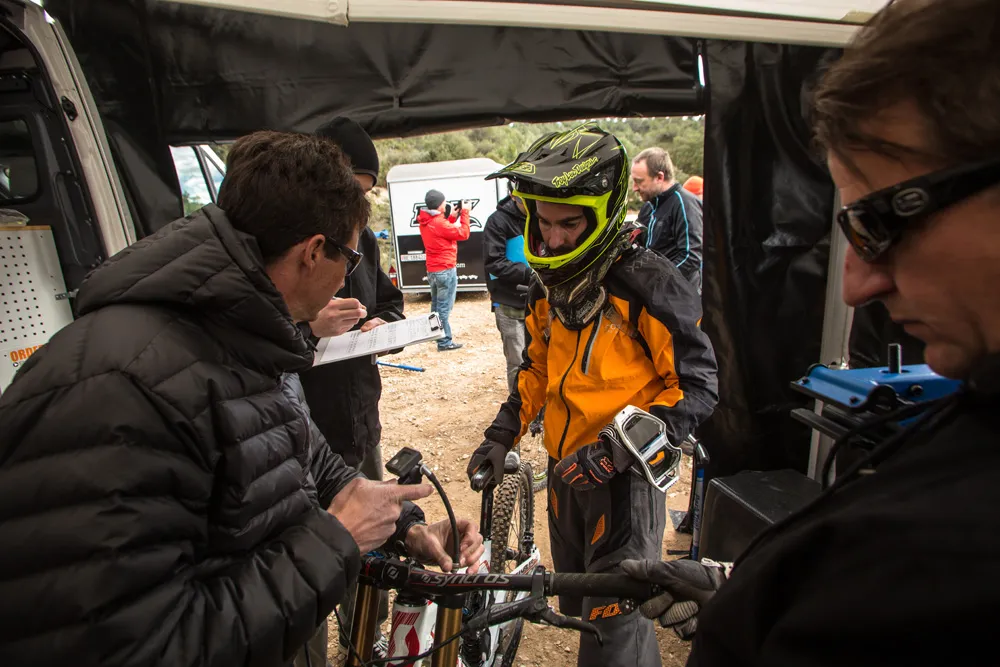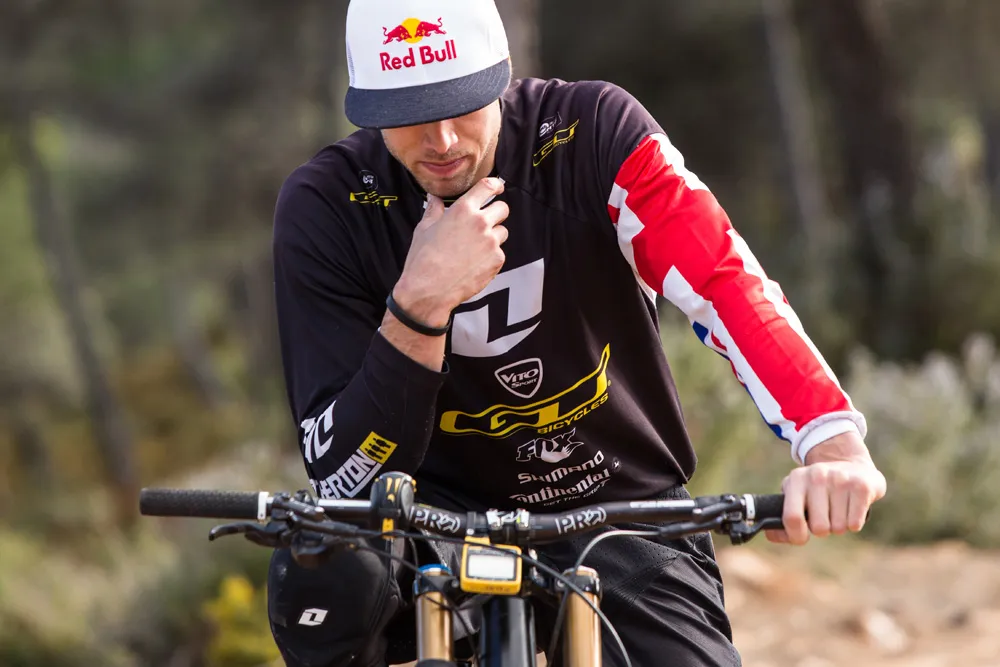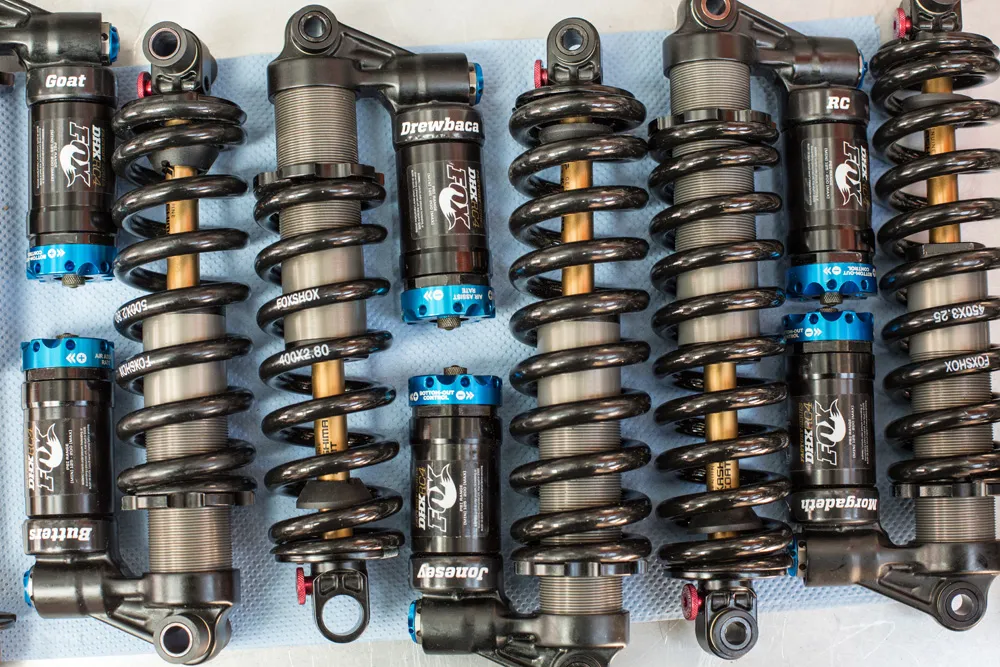Fox Racing Shox are no strangers to the World Cup podium, and their passion for racing is what pushes their development on year after year – it’s how their lighter, more adjustable 40 downhill fork and revised DHX RC4 rear shock have come to fruition. BikeRadar spent a couple of days at La Fenasosa Bike Park, Spain, for first rides of the new suspension kit.
Fox 40 Float FIT RC2 fork
Fox’s meaty, 40mm stanchioned downhill fork has been with us since 2004, when it made its first appearance on the World Cup circuit. The following year it went into production and became available to the public.
Over the last eight years it’s graced the bikes of riders including Gee Atherton, Fabien Barel, Aaron Gwin, Sam Blenkinsop, Brendan Fairclough and, most recently, the Santa Cruz Syndicate trio of Josh Bryceland, Greg Minnaar and Steve Peat.
Up until now, although the 40s have been subject to numerous refinements over the years, Fox have stuck with using a coil spring. For 2014, though, the forks have been completely overhauled from the ground up, and now proudly house a brand-new Float air spring.
Development
The 40 became the focus of Fox’s RAD (Racing Application Development) program, with the development process spanning two years and centring around a number of key objectives Fox were looking to achieve.
Among them included reducing weight, increasing compliance (which in turn improves handling), lowering the centre of mass, creating a more tunable spring, improving damping. Above all, it needed to be able to win races.
During the winter of 2010, Fox developed an inverted fork, which the eagle-eyed among you might have spotted on Gee Atherton’s bike during the US Open at Diablo Bike Park.
The inverted fork used 36mm stanchions with 48mm outer legs, a 40 FIT damper and a titanium coil spring. Although it was impressive when it came to forward and backward stiffness, the inverted design couldn’t cut it laterally.

Lower leg castings for the new 40
Fox actually produced three different 20mm axles to provide various lateral stiffnesses, but the test riders reported back that, even with the solid steel axle in place (which adds too much weight compared with the standard aluminium model), lateral stiffness was still inadequate. This is what prompted Fox to stick with the conventional 40 design, as it “offered more desirable handling characteristics at a lighter weight and a lower centre of mass”.
While sticking with the conventional design, Fox’s RAD engineers began redesigning the spring system. With the aim of developing a more progressive spring system, they used the 2011 race season to test their coil/air spring known as PABLO.
Standing for Pneumatic Assist Bottom Load Optimiser, PABLO “seals off the lower leg assembly so the fork builds air pressure during compression to provide a progressive spring rate,” say Fox.
This system was raced on by Aaron Gwin and won five World Cup races as well as the overall World Cup title in 2011. Although successful, the initial requirement for more tunability led Fox to develop a full air spring for the 40 while undertaking their 2013 Float air spring redesigns.
Air spring
Where the coil spring was previously housed now sits the all-new 40 Float air spring. Not only does the air spring help save weight, it provides a greater range of tunability, and its position within the fork also helps lower the critical centre of mass because it’s bolted into the lower left leg.
The new air spring was actually raced by Fox’s top athletes throughout the 2012 season, and was initially housed in the old 40 chassis. It still pumps out 203mm of travel, but rather than having to fiddle about with switching coil springs in and out to get the 40 set up, you can now simply attach a shock pump and dial the fork anywhere within its 45-80psi working range.
Fox spent a lot of time tuning the negative spring system to get things feeling right throughout the first 110mm of suspension travel. The negative spring is titanium, with a PVC coating to ensure it’s durable and remains quiet in action. The PVC coating is coloured, denoting the weight of the spring (just as the springs in coils within the older 40s are).
There are actually four different negative springs available – 18, 20, 22, 24lb/in. But after extensive research Fox found the 22lb/in negative spring to be the most suitable for the majority of riders. It’s what the new 40 Float fork will come with as standard.

The full spring assembly
Another key element to the 40’s tunability is the adjustable air spring compression ratio that allows riders to tweak the progressivity of the fork. In essence, it’s a nine-position volume adjuster that uses a stack of tubular washers that denote the compression ratio of the air spring.
Position one sits the air spring compression piston closer to the fork’s top cap, offering a greater volume and giving an almost coil-like, linear feel similar to that of the older, coil-sprung 40. Position nine creates the most progressive spring curve.
Actually making the adjustments is as easy as switching a coil spring, say Fox, because once you’ve released the air in the spring and removed the top-left fork cap, a 6mm Allen key is all that’s required to make the changes.
Damper
The famed FIT RC2 damper also gets a going over, and has been tuned to match the new 40 air spring. Big changes include the exclusion of a hydraulic bottom-out, which, according to Fox, isn’t a necessary or desired feature thanks to the air spring design. The reworked damper has also received a lighter cartridge tune and a Kashima-coated damper shaft to reduce stiction as much as possible.
External adjustments remain the same, and in identical positions to those of the old 40. Both low- and high-speed compression dials sit atop the right hand leg, while the rebound is still tucked away at the bottom of the right-hand leg under the protective black cap.
The effective range of adjustment is massively noticeable and something Santa Cruz Syndicate rider Josh Bryceland felt was massively impressive from day one: “You can turn a dial a couple of clicks and although you might not notice the change when riding around in the car park, you really can on the hill.”
Chassis
Internals aside, aesthetically, what many will notice first are the changes to the chassis of the 40, with key tweaks having been made around the lower leg arch, crowns and two unusual buttons at the rear of the lower legs.
The smooth lines of the cast magnesium lower legs were subject to rigorous FEA (Finite Element Analysis) testing that has helped Fox save a claimed 150g over the previous version.
Behind the arch is the full web truss arch design, which wraps neatly into the bulged seal area and new air bleed system. This new feature is designed to relieve internal air pressure build-up, which can be caused by changes in altitude or atmospheric temperature.
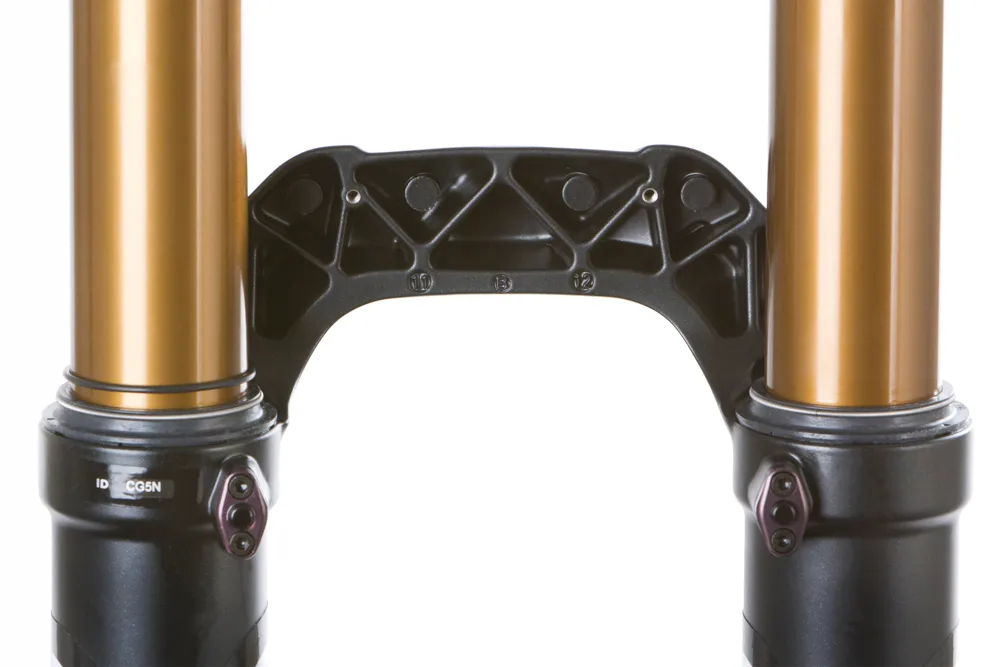
The web truss (centre) and air bleed buttons (either side)
This build-up – up to 3psi in extreme situations – can potentially affect a fork’s feel and performance. The addition of two small buttons at the rear of the lower legs lets the rider/mechanic relieve any build-up of internal air pressure easily, with little fuss and just a miniscule amount of lubrication fluid loss.
Previously, when riders noticed the air pressure build-up they’d wedge cable ties into the seals to relieve it, only to push grime into the seals. For many mountain bikers in the UK, the limited elevation (and temperature, unfortunately) means, chances are, you won’t often need to use the air bleed system.
Other changes to the lower leg casting include a new post-mount disc brake mount and axle pinch bolt system that creates an improved connection with the axle.
The stanchions, or upper tubes, also play a significant part in the all-new 40, in terms of both weight saving and handling characteristics. Fox were able to use butted stanchions, saying that, due to the lower damper pressures generated in the new 40, material from the tube walls could be removed. The now-butted upper tubes save a claimed 89g over the previous straight-gauge versions, without losing any of the bending or torsional stiffness.
Look closely at the crowns and more tweaks and changes are clear. The crown pinch bolts have shifted to the front of the crown to improve steering clearance, and, in profile, the lower crown uses a stepped design to help dissipate clamping stresses.
Fox are keen to highlight the use of a torque wrench when setting the 40s up as over/under tightening can have a marked effect on performance as well as safety.
Overall, Fox claim to have maintained the same bending and torsional stiffness characteristics across the entire 40 structure, features that have been present from the first production run in 2005 all the way through to 2012.
However, for 2014, thanks to the changes to the lower leg casting and upper tubes, the 40 will be more compliant. This can in turn increase rider comfort and grip.
Other big chassis-related news is that Fox are also producing a specific 650b lower leg assembly, which includes all the same features as that of the standard 40 but with the dropouts shifted 14mm down and 7mm outwards – no doubt a nod to the momentum behind the increasing popular wheel size and its shift into the world of downhill.
Fox claim a total weight loss of 476g (1.04lb) over the coil-sprung 40, with the biggest saving coming from the new lower leg casting and air spring. The air spring is in fact the most significant factor, saving a claimed 152g in total. This brings the weight of the Fox 40 Float FIT RC2 fork to a claimed 2,711g (5.98lb).
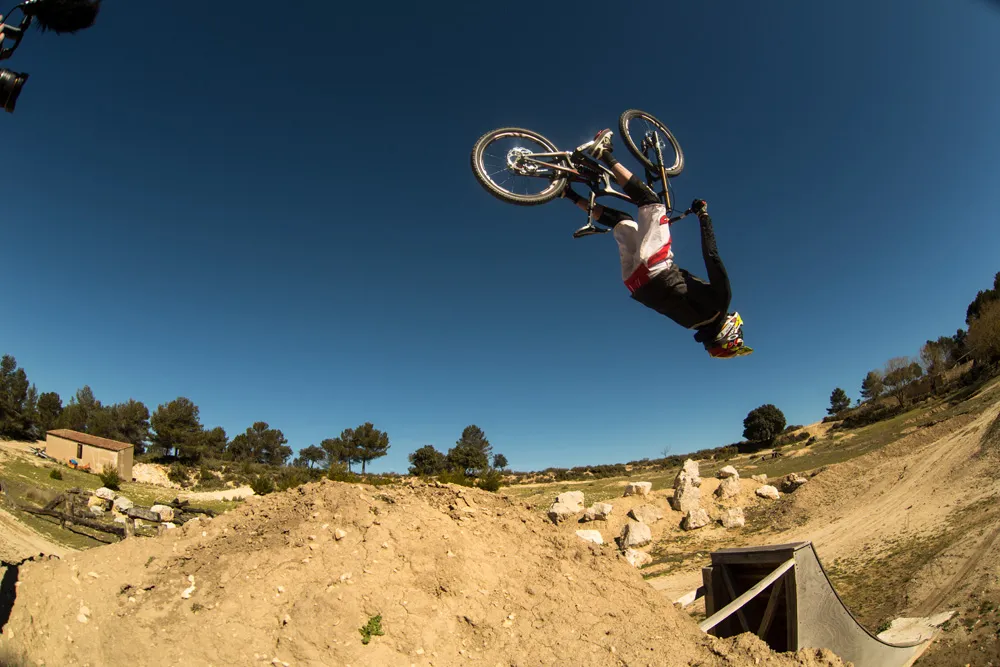
Greg Minnaar in action with the new fork
Initial impressions
At La Fenasosa, we put the new 40 Float through its paces for 15 rough and rocky runs. Working closely with the Fox engineers, we were able to get the fork dialled in just right for the terrain and our riding style – a tweaking process made vastly easier with the new air spring.
What was initially surprising was just how effective small adjustments to air pressure and compression settings were on the trail. Little changes to air pressure became a night/day difference on the hill, while a couple of clicks on either of the compression dials seemed to transform the ride completely.
One run you’d be getting hung up on the savage momentum-sapping rock fields, then with just a couple of clicks here and there you’d be skipping over the tops of the boulders and carrying way more speed.
The air spring itself remained consistent no matter how aggressive the riding or terrain became and, thanks to the tuneable progressivity, felt just as we’d have hoped.
Overall, the weight saving, additional compliance, range of tunability and superb FIT RC2 damper could make the 40 a tough one to beat. BikeRadar will have a full review in the coming months, when we’ve got some more familiar terrain under our wheels.
DHX RC4 rear shock
In a bid to create a more cohesive package with the new 40 Float fork, Fox wanted to make some changes to their flagship downhill shock, too.
Development
The overall goals Fox set out to achieve with the DHX RC4 were pretty straightforward: improve the damping control and increase the sensitivity and responsiveness of the shock.
Their RAD (Racing Application Development) program set about making the changes to the shock during the 2011 World Cup season, when the company experimented with different chassis designs as well as drawing on information from their Power Sports division.
Changes
Fox’s research highlighted that many frame manufacturers were creating more progressive suspension designs that required a more linear shock tune, which is exactly what the DHX RC4 now features.
Fox have also extensively reworked the RC4’s internals, and fully redesigned the valve system. Where previously much of the RC4’s damping was generated in the base valve, damping duties are now more evenly split between that component and the main piston. This helps lower internal pressures when the same shaft force is applied, leading to improved sensitivity over small bumps as well as improved damping control.
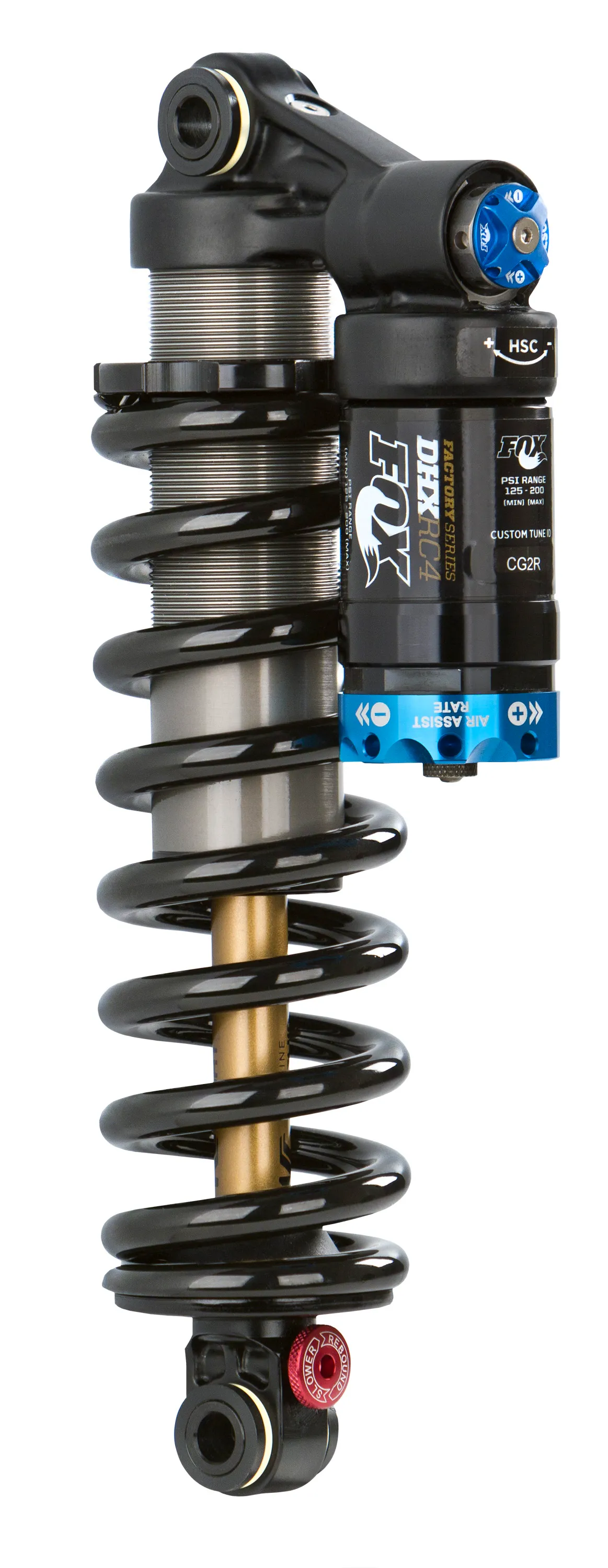
The newly refined DHX RC4 shock
With the main piston generating more of the damping, it doesn’t need to be supported by high IFP (Internal Floating Piston) pressures, which Fox say can lead to force discontinuities acting on the shaft, having a detrimental effect on high speed control.
This, combined with the increased progressivity being built into frames, has meant the RC4 no longer needs Boost Valve technology. The lower IFP pressure also means lower friction on the seals, which also helps improve sensitivity.
Another big change we spotted over a year ago on Aaron Gwin’s pro bike is the change in shock shaft diameter. Previously measuring in at 15.875mm (5/8in), the shaft has been whittled down to 12.7mm (1/2in), resulting in decreased friction and improved sensitivity. Fox claim their riders have actually noted an increase in traction as a result.
Initial impressions
Just as we noted with the new 40 Float fork, the DHX RC4 boasts a noticeable, effective range of external adjustment that can really help you get the back end of the bike feeling just right.
When we managed to get the shock set and balanced with the fork, traction through the rear tyre was impressive even on loose Spanish soil. No matter how hard we clouted through rock sections we couldn’t faze the RC4, which continued to deliver grip and control whenever called upon.
Again, BikeRadar will have a full review of the new DHX RC4 rear shock in the coming months.
